

July 2014
IN THIS ISSUE:
![]()
- Genetic disorder may help find a way to reduce heart disease
- Project SEARCH Class of 2014 focuses on future in the community and NIH
- Astronaut brings stories of science and space to Clinical Center patients, staff
- Elevator operator lifted patients and their spirits
- HHS Tribal Advisory Committee holds roundtable meeting, tours hospital
- The Talk Shop: Language interpreters provide critical health care services
- Golf event benefits research participants
- Staff 'Take a Hike' to stay healthy
- NIH director awards Clinical Center staff for dedication
- Brothers and sisters of pediatric patients encouraged to attend Sibling Day, July 15
Print this Issue ![]() (548 KB)
(548 KB)
ABOUT CC NEWS:
![]()
Published monthly by the Office of Communications and Media Relations. News, article ideas, calendar events, letters, and photographs are welcome. Submissions may be edited.
Clinical Center News
National Institutes of Health
Building 10, 10 Center Drive
Room 6-2551,
Bethesda, MD 20892-1504
Tel: 301-594-5789
Fax: 301-402-0244
Molly.hooven@nih.gov
QUICK LINKS:
![]()
Genetic disorder may help find a way to reduce heart disease
New insights into a rare genetic disorder affecting the immune system may lead to treatments for atherosclerosis, the arterial plaques or blockages that are one cause of heart disease. Dr. John I. Gallin, director of the Clinical Center, presented on the advancements at a recent Contemporary Clinical Medicine: Great Teachers Grand Rounds Lecture. Dr. David Bluemke, director of Radiology and Imaging Sciences at the hospital, also presented on the use of new medical imaging techniques to detect atherosclerosis.
Gallin gave a brief history of the genetic immune disorder, chronic granulomatous disease, and explained the important role it may play in protecting a person from the consequences of atherosclerosis. Bluemke highlighted the advances medical imaging has provided for early diagnosis of atherosclerosis.
Chronic granulomatous disease affects roughly 1 in 200,000 people, said Gallin. The disorder prevents white blood cells known as phagocytes from producing chemicals that eliminate harmful pathogens in the body. The disease is characterized by recurrent infections and granulomas, or small areas of inflammation, on the skin and inside the body that can lead to severe lung, skin, bone and other organ damage.
Gallin said the cause of the disease can be traced to five mutations in an enzyme complex called NAPDH oxidase. Conditions range in terms of severity depending on which type of mutation a person has. Gallin and his colleagues have used what they learned about each mutation to develop individualized therapeutic approaches for different types of chronic granulomatous disease.
Over the years, Gallin noticed that people with the disease developed atherosclerosis at a slower rate than those without it. Soon, other researchers began publishing articles with similar conclusions.
A protocol was developed at the Clinical Center to assess the prevalence of atherosclerosis in patients with immune system disorders compared to those without. The results of the protocol confirmed Gallin's hypothesis.
"What we've shown is that chronic granulomatous disease patients are protected from carotid artery thickening," Gallin said.
Now, his team is working with the NIH's National Center for Advancing Translational Sciences to identify potential drug targets. To continue advancements, Bluemke highlighted that researchers are using new medical imaging techniques such as CT, MRI and PET to detect atherosclerosis, as early as possible.
The research on these disorders, which is still ongoing, could have profound impacts on cardiovascular disease, which is the leading cause of death in the U.S. and costing health care more than $400 billion annually according to the American Heart Association.
Bluemke noted that doctors need noninvasive imaging methods to detect early atherosclerosis. Traditionally, doctors look at atherosclerosis risk factors, such as age, gender, blood pressure, family history and cholesterol levels to determine risk. These risk factors work well for large populations, but are less helpful for each individual patient.
At the Clinical Center, new medical imaging techniques are allowing researchers to identify early signs of atherosclerosis before a patient shows any symptoms using CT and MRI of the blood vessels in the heart and neck.
The next step is figuring out how to treat it. Clinical trials are underway at the hospital to compare image-guided approaches to lowering atherosclerosis risk factors with standard care guided by traditional risk factors.
Preliminary evidence suggests that atherosclerosis is a reversible condition, according to Bluemke. In one trial, patients were treated with statins, which are a cholesterol-lowering medication, for a year and a half. The statins decreased the amount of plaque in the arteries.
"A disease which we didn't really envision as being reversible has a possibility of being regressed in this manner," said Bluemke.
An additional benefit is that the image-guided approaches to treating atherosclerosis are non-invasive and the risk of radiation exposure is low.
Project SEARCH Class of 2014 focuses on future in the community and NIH
 |
Graduates of the Project SEARCH-NIH Program, seen above, worked at seven Institutes and Centers across campus. |
Twelve men and women graduated June 12 from the Project SEARCH-NIH Program. The initiative, which started at the Clinical Center in 2010, provides young adults with intellectual disabilities the opportunity for an independent future.
Over 10 months, the interns acquired work experience along with competitive, marketable and transferrable skills to help them gain successful paid employment at the NIH or in the community.
Amethyst Thornton, a 2010 graduate from the program, spoke at the ceremony about her time as an intern and her experience being hired as a federal employee.
"When I first started the program, I had mixed emotions. By the end...I was feeling confident, proud and responsible," Thornton said. "My advice to the new graduates is never give up, practice makes perfect and always try your best!"
Learn more about the Project SEARCH-NIH Program and its partners
Astronaut brings stories of science and space to Clinical Center patients, staff
 |
Michael S. Hopkins (right) visits Adrian Istoc on 1NW. |
On June 10 NASA astronaut Col. Michael S. Hopkins, U.S. Air Force, spoke about his 166 days on the International Space Station and how his experiences are helping scientists understand the health effects of living in space.
The National Institute of Arthritis and Musculoskeletal and Skin Diseases hosted the lecture. They have joined the National Institute on Aging and the National Institute on Biomedical Imaging and Bioengineering in funding three basic research projects that make use of the International Space Station to explain how gravity influences cell behavior on Earth.
"One of the neat things about what we do up there is executing science experiments. We often times get opportunities to talk to investigators here on the ground but we never get to see them. All we hear is a voice and we never get to see a face," Hopkins said. "I'm very excited to be here today because now you get to see the [NIH] people that are involved in some of these experiments that we get the privilege of executing up on the Space Station."
Hopkins launched with Russian cosmonauts Sept. 25, 2013 from the Baikonur Cosmodrome in Kazakhstan to the International Space Station, which is about the size of a football field, and returned to Earth March 10, 2014. He logged almost 13 hours outside the orbiting outpost while conducting two spacewalks. Hopkins said they went around the earth every ninety minutes. For two months after his return, he underwent scientific tests to determine how his time in a microgravity environment affected his body.
"One of the nice things about space is it makes the impossible possible," Hopkins said as he showed a video during the lecture on his travels.
NIH and NASA continue to explore new ways to develop partnerships that serve shared scientific interests. Read more on NIH and NASA and view the lecture 'How to Train like an Astronaut'.
![]()
Elevator operator lifted patients and their spirits
 |
Photo of John Botts from a 1966 NIH Record. |
In the 1950s, many employees, patients and visitors who entered the NIH Clinical Center immediately stepped aboard the central elevators to get to their destination. Instead of hearing 'What floor?' or 'Any room for me?' the first thing heard was "God Bless You" from elevator operator Reverend John H. Botts. The NIH Record said at one time he was 'probably one of the most recognized and popular figures at NIH.'
Botts became a Reverend in the 1940s and conducted services among seven sanctuaries of the Church of God in Washington.
With open arms and open elevator doors, Botts began his career as an operator around 1955. There was no Mark O. Hatfield Clinical Research Center or Ambulatory Care Research Facility at that time. The elevator bank near Masur Auditorium was close to the main entrance.
He tried to address only those who seemed to be downcast or would welcome his conversation. During his 27 years of service to the NIH he touched the lives of many, including President Lyndon B. Johnson. In 1965 the President came to NIH to sign the Nation's Health Research Facilities Amendments. After he finished his tour of the Clinical Center he stepped aboard the elevator and Botts said, "God bless you, Mr. President." Johnson simply replied, "God bless you, too."
At a Great Teachers lecture in 2013 Dr. Phillip Gorden, director emeritus and senior investigator with National Institute of Diabetes and Digestive and Kidney Diseases, spoke of Botts to an audience who had likely never heard of him and may not have known there was a person who operated the elevator.
"When you got in his elevator, you received so many blessings that you didn't know whether you were going to the 14th floor or Heaven," said Gorden. "When you saw the faces of fear coming to a new place and faces of disease that they were confronted with, and you saw this kindly gentleman give them so much relief and consolation...it was a remarkable example of what this institution is."
Botts retired in 1981 ![]() (21 MB). Just two years later the hospital began to convert passenger elevators to an automated, non-operator-controlled, system to enhance efficiency.
(21 MB). Just two years later the hospital began to convert passenger elevators to an automated, non-operator-controlled, system to enhance efficiency.
HHS Tribal Advisory Committee holds roundtable meeting, tours hospital
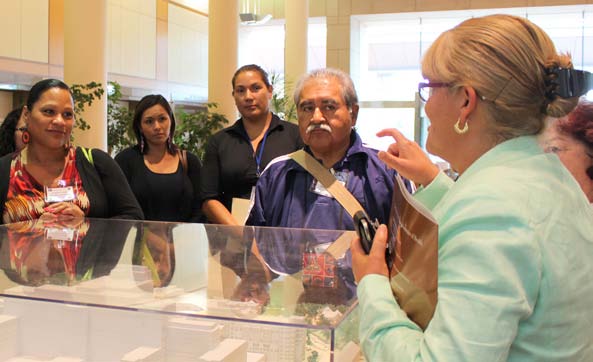 |
Members of the STAC began their tour of the hospital at a model of the Clinical Center. |
Representatives from the Health and Human Services (HHS) Secretary's Tribal Advisory Committee (STAC) visited the Clinical Center June 3. The STAC is comprised primarily of Tribal leaders whose purpose is to exchange views, share information and provide recommendations in relation to intergovernmental responsibilities or administration of HHS programs by engaging in government-to-government dialogue.
Officials provided an overview of new initiatives and a discussion of intramural training programs and opportunities. A roundtable was presented by Native American fellows from the Clinical Center Nursing Department and Department of Bioethics, Eunice Kennedy Shriver National Institute of Child Health and Human Development, National Institute of Neurological Disorders and Stroke and National Human Genome Research Institute. The fellows include Tamara James, Choctaw Nation; Naomi Lee, Seneca Nation; Teresa Brockie, White Clay Nation; Rianna Albers, Lakota Nation; Kristen Regini, Tule River Yokuts Nation; and Deana Around Him, Cherokee Nation.
The Talk Shop: Language interpreters provide critical health care services
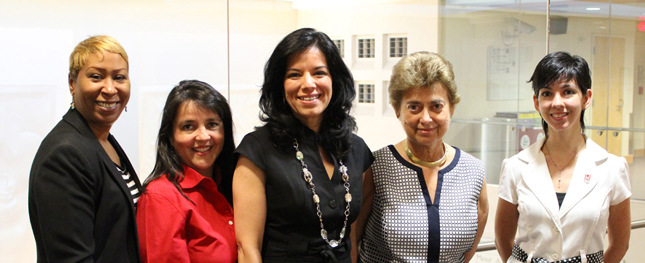 |
(From left) Maria Elena Guzman, program specialist, Heidi Hobson, interpreter, Brenda Robles, program coordinator and interpreter, Maria Radulovic, interpreter, and Rosa Garay, interpreter intern, work in the Language Interpreters Program. |
Navigating the health care environment can be tough. Imagine doing it in another language. Patients do this every day at the Clinical Center. Fortunately they have the hospital's Language Interpreters Program to help.
The Language Interpreter's Program features four full-time staff who are Certified Medical Interpreters. Interpreters provide service in Spanish, the most requested language, German, French and Portuguese. The program also manages and provides remote, phone-based interpretation service in 90 languages through a contractor.
Interpreters on staff are supplemented by 40 trained volunteer language interpreters and paid interns with the Hispanic Association of Colleges and Universities.
Brenda Robles, the program's coordinator, said the goal of the Language Interpreters Program is to "break down language barriers, cultural barriers and make sure that communication is swift, clear and precise."
"In matters of health it is crucial to provide skilled and precise language interpretation. Using family members or 'getting by' is not adequate," Robles said. "[Language interpreters] are here as linguistic experts and advocates to bridge language and cultural gaps and to partner with excellent health care providers to reach successful health care outcomes. We ensure that quality communication is achieved throughout the patient's experience at the Clinical Center."
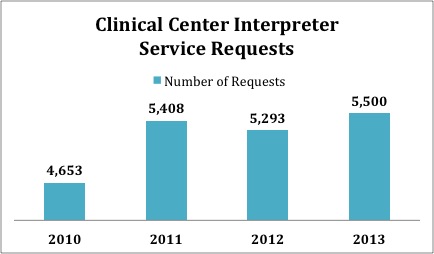 |
The most recent data shows that requests for interpreters vary per year. The top ten language requests in 2013 include: Spanish, Russian, Mandarin Chinese, Korean, Portuguese (including Brazilian and Portuguese dialects), Arabic, French (including French Canadian, Creole and Caribbean dialects), Italian, Vietnamese and Hebrew. |
And the numbers bear out. Requests for language interpretation service in the Clinical Center reached 5,500 in 2013, a 15% increase from 2010.
One challenge for the program is addressing requests for interpretation of less common languages.
"[Recently] we had a protocol come in to [an institute] where they recruited from a tribe in northeast Uganda. The language was Acholi, a tribal language from that area and very rare. We were able to reach out to the local community and identify three volunteers who came in and helped us," stated Robles.
Requests for interpreter services have been increasing in part because the NIH institutes that work in the hospital have increased their outreach.
"In this last year one of the liver protocols started working very heavily in the community in Silver Spring" Robles said. "We started seeing a trend where many Spanish-speaking patients began to come to the Clinical Center, so our need for Spanish [interpretation] grew."
While challenging, Robles stated that interpreting for people who are in health distress can be incredibly rewarding.
"When you're sitting across the table from someone who has immense healthcare needs and you become the voice that helps them to understand and connect with their health care provider, there's no more rewarding feeling than that."
The Clinical Center is working on a language access plan, as part of a NIH-wide effort, to ensure that patients, research volunteers and visitors with limited English proficiency have meaningful access to information related to their interests or participation in clinical research. Developments will be forthcoming.
Golf event benefits research participants
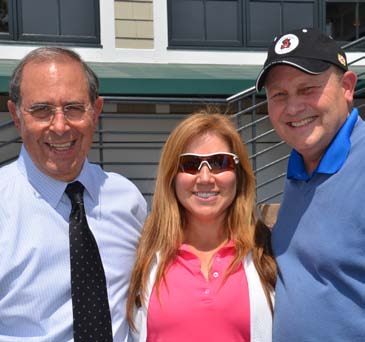 In May, Clinical Center Director Dr. John I. Gallin (left) gave remarks at the Friends of the Clinical Center (FOCC) [disclaimer] charity golf tournament. Above, Gallin joins Heidi Grolig, FOCC executive director, and Jeff Vigne, FOCC board president.
In May, Clinical Center Director Dr. John I. Gallin (left) gave remarks at the Friends of the Clinical Center (FOCC) [disclaimer] charity golf tournament. Above, Gallin joins Heidi Grolig, FOCC executive director, and Jeff Vigne, FOCC board president.
The non-profit helps enable the Clinical Center to discover life-saving cures by providing urgently needed support to patients. About 60 to 70 patients benefit each year directly from FOCC services. Countless others receive support from additional NIH charities.
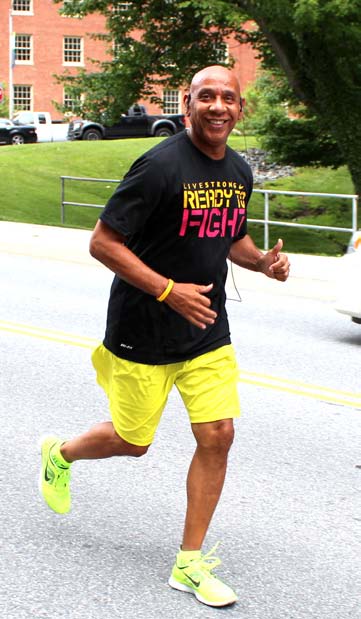 Staff 'Take a Hike' to stay healthy
Staff 'Take a Hike' to stay healthy
NIH held the 7th annual "Take a Hike Day" walk and fun run June 3. Michael Alexander (right), hospitality services coordinator at the Clinical Center, along with 1,200 other members of NIH covered 3.25 miles, or 6,500 steps, around campus.
The event was sponsored by the NIH Office of Management and the NIH Recreation and Welfare Association [disclaimer].
NIH director awards Clinical Center staff for dedication
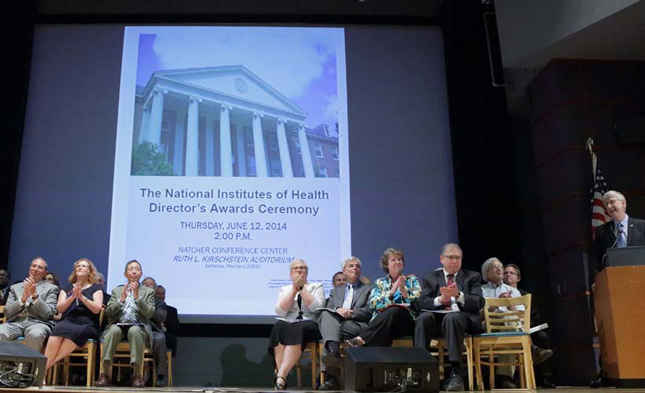 |
Dr. Francis S. Collins, NIH director, right, honored hundreds of staff members at the NIH Director's Award Ceremony in June. Co-workers, friends and family of awardees were in attendance to celebrate their accomplishments. |
Over twenty Clinical Center staff members were honored at the 2014 Director's Awards Ceremony June 12.
Dr. Francis S. Collins, NIH director, recognized employees from across campus that have shown superior performance and special efforts significantly beyond the regular duty requirements, and directly related to fulfilling the mission of the NIH. The theme of the awards ceremony was "Why I Love NIH." Collins highlighted that staff accomplishments are truly a work of love that demonstrate a commitment to NIH's goal of improving the health of the nation and the world at large.
Clinical Center employees earned the NIH Director's Award (which was comprised of three categories: Scientific and Medical; Administrative; and Technical, Clerical and Support), the Ruth L. Kirschstein Mentoring Award and the NIH Equal Opportunity Award.
Awardees include: Benjamin Abad, Dina Pokuaa, Cuthbert St. Clair, Paul Wilcher, Scott Hotaling, Josette Blocker, Tramaine Davis, Judith Downing, Kasan Bryant, Deborah Kolakowski, Gina Ford, Ryan Kennedy, Susie Postal, Tricia Coffey, Adrienne Farrar, Harvey Klein, Robert Lembo, Denise Ford, Jennifer Simmons, Michelle Holshue, Richard Kwan, Lindsay Matthews, and Julia Purdy.
View additional details on the awardees above and view all award winners. Watch a video of the ceremony.
Brothers and sisters of pediatric patients encouraged to attend Sibling Day, July 15
The siblings of Clinical Center pediatric patients should mark the calendar and join the 7th Annual Sibling Day scheduled for July 15 from 9 a.m. to 3:30 p.m.
The special day to celebrate 'Super Sibs' allows the patient's brothers and sisters to feel proud of the important role they play both at home and on the health care team.
Sibling Day will include hands on activities in the operating room, a fantastic voyage in the department of laboratory medicine, a chance to get inside the mock scanner and much more — each of which enables them to better understand the medical environment.
In the afternoon, The Children's Inn will have a lunch followed by therapeutic games and art activities. An awards ceremony and ice cream social will be held for the Super Sibs at the end of the day. The Super Sibs families and staff are invited to attend at the Inn.
Staff can help ensure that families with pediatric patients know of about the special day just for siblings. Find more information and sign up for the day by calling The Children's Inn at 301-496-5672 or emailing whitedrm@mail.nih.gov and wienerl@mail.nih.gov.
NOTE: PDF documents require the free Adobe Reader.
 The information on this page is archived and provided for reference purposes only.
The information on this page is archived and provided for reference purposes only.